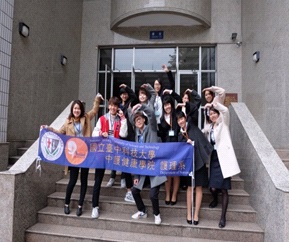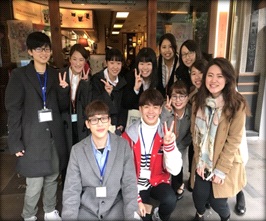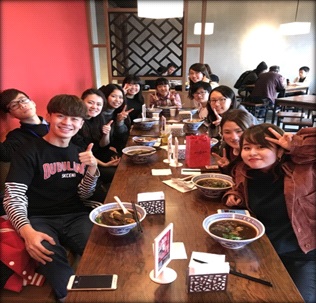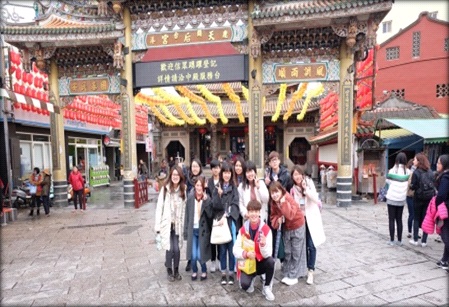国立台中科技大学看護学科を研修会場として実施した本研修は、両大学からの参加者72名がAからFの6つの混合班に分かれて、プレゼンとディスカッションを核として、看護教育や医療の先端的施設の見学、台湾の古い町並みの探訪、班別の自由企画活動など、学生が中心となってさまざまな活動を協働して行いました。各班のメンバーからジョイント研修活動の感想が送られてきましたので、そのなかからC班のものをご紹介します。
Group C
王婷儀Wang, Ting-Yi (Christina)、束其泓Shu, Chi-Horng (Eric)、
余豪晉Yu, Hao-Jin (Wesley)、郭筱祺Kuo, Hsiao-Chi (Stacy)
陳連瑩Chen, Lian-Ying (Peggy)
First of all, we are very happy and glad to have been able to participate in the
NTUST-JRCKICN Joint Transcultural Communication Program and have a good
friendship with all the participants, especially Japanese cute girls in our group C.
This was the second time for our Nursing School to have friendly collaboration
with Japanese Red Cross Kyushu International College of Nursing.
For their five-day visit, our school prepared for three categories of activities based
on the main idea of nursing in this program: “Academic,” “Clinical,” and “Cultural.”
“Academic” represents the knowledge of nursing; we showed introduced our laboratory
and center for Objective Structured Clinical Examination (OSCE) to each visiting member.
About the “Clinical” area, we arranged a visit to Chang Bing Show Chwan Memorial
Hospital in Lugang Town to learn about the most advanced medical care in Taiwan.
The highlight of the tour in the hospital was visiting the IRCAD Center (Institut de
Recherche contre les Cancers de l’Appareil Digestif/Research Institute against
Digestive Cancer), which is the first and the only one in Asia.
For the category of “Cultural” area, we planned a variety of tours in Taichung so that
our group Japanese members could experience the culture of Taiwan. Those tours
made them get interested in Taiwanese traditional and modern cultures. The places
we visited included the National Taichung Theater, Yizhong Street, Tunghai Night Market,
Lukang Pedestrian Street and so on. In this joint program, we did not hope this journey
would be just for sharing nursing knowledge. We also hoped to enjoy Taiwanese culture
together, whose objective was attained.
The following articles for sharing our precious memories of the joint program are written
by the members in Group C, Christina, Eric, Wesley, Stacy, and Peggy.
From Christina:
Hello!! I’m Christina, a four-year student at NTUTC, School of Nursing, and a leader
of Group C during this joint program. I am most honored to have been able to collaborate
with such lovely companions from Japan. In this five-day program, we met five beautiful
and warm-hearted friends, Yuki, Hana, Miwa, Hiroka, and Aya. They always showed us
big smiles to break the distance between us even at the beginning of the program or on
those hard days when we were involved in discussing lots of serious issues and topics.
When we discussed a topic of “married or unmarried,” I was so surprised that the reason
causing this problem in both Japan and Taiwan was quite so similar. Exchange of our
views on the trend of staying unmarried made us all learn a lot although we could not
figure out how to solve this problem in both societies.
In addition to giving presentations every day, we shared really valuable time and space
by enjoying sightseeing together, which was full of joy and laughing. I am so happy
that each member of my group could have a wonderful time in this short visit to
Taichung,Taiwan.
I wish you all the best and we will be able to see each other again!!
From Peggy:
It was a great experience for me to have been able to take part in this joint program,
although it was a short-term program. I have got an unforgettable memory by spending
those Japanese students and feel grateful to everybody. This joint program helped us
experience cultural differences and similarities between Taiwan and Japan.
The most impressive activity was a tour to Changhua Lukang, where we visited the
top-class hospital in Taiwan, also in Asia, Chang Bing Show Chwan Memorial
Hospital, in Lugang Town. The hospital also has the IRCAD Center, which was
very innovative.
I felt it pitiful to have such a short time for a sightseeing of Lukang Pedestrian Street.
The meeting time for our moving to the Chang Bing Show Chwan Memorial Hospital was
too pressing for us to travel the whole Street. However, we had a good time with the
Japanese friends, wishing the time would be prolonged.
On the final night of the program, our group members walked along Taiwanese
avenue to Tunghai, where we ate beef noodles, one of the Taiwanese foods. I was
very glad that Japanese students loved it. After that we went to the National Opera
House. We also advised the Japanese friends in their buying suveniors. We had a
really great time.
From Stacy:
I am very happy to have participated in this joint program. I made a lot of Japanese
friends and learned a lot of new things from them. A visit to Chang Bing Show Chwan
Memorial Hospital and its IRCAD center, a training center for minimally invasive surgery,
was my first experience, which really made the scales from my eyes. They have not only
the most advanced equipment but also provide medical care providers with excellent
resting space. This visit to the hospital gave me another new choice for my future work.
At the beginning of the program, I was afraid of speaking English, but the students from
Japan were so patient to chat with me. We mutually learned a lot about differences
and similarities between both cultures. We also found some interesting things through
presentations and discussions on ikemens, temples, shrines, and some dishes which
had the same names in Japanese language and Taiwanese language. The most
interesting event in our group was that Japanese students tried to have a Taiwanese
local food called “Stinky Tofu.” Japanese students did not like it, but, amazingly, they
ate it up, which was so touching as well as funny. We were also impressed by their guts
of trying foreign foods. I am very happy to meet these five Japanese friends, including
other group members and group leaders. Those five days gave me a great chance to
learn a lot as well as to know what were the weak points in me.
From Eric:
I am Eric. I am so glad that I was a part of group C. It is a nice exchange program.
I think it gave us a chance to improve our English speaking and listening skills.
We have been also able to make friends with Japanese students and have great
conversations with them. I hope we will be able to go to Japan next time. I suggested
our teachers that we should hold such an exchange program in Japan. It would be a
nice experience for us nursing students to learn how Japanese nurses work and how
different the medical environments are between Taiwan and Japan.
The happiest time during the joint program was Friday, 9, February; because we could
have our own group’s time to have fun. We went to Tunghai to eat many kinds of food
and we shared the differences of mutual culture. Anyway, the happy time always
goes fast. I hope each of the participants in this joint program will be able to realize
their own dream and will never forget those memories.
From Wesley:
As soon as that five-day joint program was over, I felt very sad, remembering the first
day of the program when we took Japanese students to taste some typical Taiwanese
foods such as fired chicken, pearl milk tea, and stinky tofu which we Taiwanese loved.
When we recommend the Japanese friends just to try stinky tofu, 臭豆腐 in Chinese,
they tried only one bite. Ha, ha, ha, however, they could never eat any more.
I believe that experience was the most precious moment for them.
On the next day, we introduced each other based on Japanese and Taiwanese attractions
and culture in the presentations. The presentations on Japanese anime and several types
of Japanese ikemen, nice guys, made me learn a lot of differences in preferences
according to the nations.
In the afternoon of that day, we took them to Objective Structural Clinical Examination
Center, which has a simulator called AYong and costs two million Taiwanese dollars to
develop that simulator like a real human. Inside his body the computer works to adjust
the heartbeat, pulse, blood pressure, respiration, and coma index; even diseases can be
set in it, which is the outcome of highly advanced technology. Japanese friends
and I were overwhelmed by those simulation dolls.
Furthermore, we enjoyed a tour to Lukang, one of the Taiwanese old towns where
traditional culture has still remained. We tasted the local foods such as oyster omelet
and oyster fritter. Japanese friends also tried candied haws and some black caviar.
Along the street, we enjoyed the historical sites and traditional buildings. On the final
night of the program, we took them to the downtown area of Taichung City.
The feelings of our group members were very good just like a family after we worked
hard every day to discuss and prepare for the presentation.
Those five days when we collaborated in a variety of activities will be the best memory
in my life. I really hope that next time we Taiwanese students will be able to visit Japan.
I miss every Japanese friend and love all the guys~~~ Thanks to our cute Japanese
members, we learned a lot about Japanese culture.
This is a valuable and unforgettable memory for me. I hope that we will be able to see
each other again soon!


<写真左:すぐに仲良くなったグループCのメンバー>
<写真右:台中市のダウンタウンにて>


<写真左:みんなで味わった台湾料理>
<写真右:鹿港の街の古い寺院にて>









